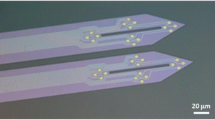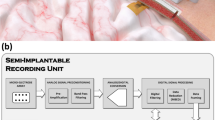Abstract
An electronic circuit for measurement of temperatures is described utilizing silicon diodes as temperature sensors and the feature that the reverse current flow of a diode is linearly related to temperature. Once calibrated and implanted into various sites of the body core of rabbits, the diodes preserved their precise temperature sensing qualities for periods longer than a year. Temperature changes of the atlanto-occipital membrane were found to be close to simultaneously measured intracisternal temperature, both temperatures being some 0.3°C higher than rectal temperature. This temperature-relationship persisted under conditions with different states of cutaneous vasoconstriction and thermal panting as observed in fever and during defervescence. These results indicate that extrahypothalamic brain regions as the cerebellum and the medulla oblongata do not benefit from the proposed protective function of brain cooling during stimulation of heat dissipating effector mechanisms.
Similar content being viewed by others
References
Baker MA (1982) Brain cooling in endotherms in heat and exercise. Ann Rev Physiol 44:85–96
Caputa M, Kadziela W, Narebski J (1976) Significance of cranial circulation for the brain homeothermia in rabbits. II. The role of the cranial venous lakes in the defence against hyperthermia. Acta Neurobiol Exp 36:625–638
Chungcharoen D, Daly M de Burgh, Neil E, Schweitzer A (1952) The effect of carotid occlusion upon the intrasinusal pressure with special reference to vascular communications between the carotid and vertebral circulations in the dog, cat and rabbit. J Physiol (Lond) 117:56–76
Inomoto T, Mercer JB, Simon E (1982) Opposing effects of hypothalamic cooling on threshold and sensitivity of metabolic response to body cooling in rabbits. J Physiol (Lond) 322:139–150
Kluger MJ, D'Alecy LG (1975) Brain temperature during reversible upper respiratory bypass. J Appl Physiol 38:268–271
Kohlrausch F (1968) Praktische Physik. Teubner, Stuttgart
Krause W (1884) Die Anatomie des Kaninchens. Engelmann, Leipzig
Mercer JB, Jessen C (1980) Thermal control of respiratory evaporative heat loss in exercising dogs. J Appl Physiol 49:979–984
Riedel W, Kozawa E, Iriki M (1982) Renal and cutaneous vasomotor and respiratory rate adjustments to peripheral cold and warm stimuli and to bacterial endotoxin in conscious rabbits. J Auton Nervous System 5:177–194
Riedel W, Hales JRS (1983) Prostaglandins modify tissue blood flow and respiratory rate in febrile rabbits. J Ther Biol 8:199–201
Sugano Y, Nagasaka T (1980) Effects of tracheal bypass breathing on heat balance in rabbits. Jap J Physiol 30:701–708
Author information
Authors and Affiliations
Rights and permissions
About this article
Cite this article
Klein, W., Riedel, W. Long-term recording of core temperatures with chronically implanted silicon diodes. Pflugers Arch. 403, 55–57 (1985). https://doi.org/10.1007/BF00583282
Received:
Accepted:
Issue Date:
DOI: https://doi.org/10.1007/BF00583282




